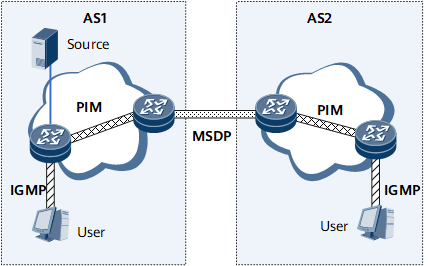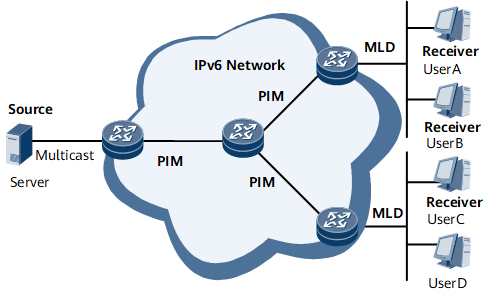Multicast Protocols
To implement a complete set of multicast services, several multicast protocols need to work together, as shown in Figure 1 and Figure 2.
The NetEngine 8000 F supports various multicast routing protocols to implement different applications. Table 1 describes commonly used multicast routing protocols.
Network |
Multicast Protocol |
Protocol Function |
|---|---|---|
Between a user host and a multicast router |
|
Allows hosts to access multicast networks:
|
Between multicast routers in the same domain |
Protocol Independent Multicast (PIM) |
Routes and forwards multicast packets:
|
Between multicast routers in different domains |
Multicast Source Discovery Protocol (MSDP) for IPv4 networks |
Inter-domain multicast source information sharing: Transmits source information between routers in different domains. |
Multicast protocols have two main types of functions: managing member relationships; establishing and maintaining multicast routes.
Managing Member Relationship
IGMP/MLDsets up and maintains member relationships between hosts and routers.
IGMP applies to IPv4 networks with the following variants:
IGMP has three versions: IGMPv1, IGMPv2, and IGMPv3. At present, IGMPv2 is most widely used. IGMP versions are backward compatible.
All the IGMP versions support the Any-Source Multicast (ASM) model. IGMPv3 can support the Source-Specific Multicast (SSM) model independently, while IGMPv1 or IGMPv2 needs to work with SSM mapping to support the SSM model.
MLD has two versions: MLDv1 and MLDv2.
MLDv1 is similar to IGMPv2, and MLDv2 is similar to IGMPv3.
Both of the two MLD versions support the ASM model. MLDv2 supports the SSM model independently, while MLDv1 needs to work with SSM mapping to support the SSM model.
Establishing and Maintaining Multicast Routes
A multicast route, also called a multicast distribution tree, refers to the data transmission path from a multicast source to all receivers. The path is unidirectional, loop-free, and the shortest available path. Multicast data packets can be forwarded only after multicast routes are established and maintained among routers.
Intra-domain multicast routing protocols discover multicast sources and establish multicast distribution trees in an autonomous system (AS) to deliver information to receivers.
Inter-domain multicast routing protocols transmit multicast source information between domains to set up inter-domain routes. Multicast resources can then be shared among different domains. MSDP is a typical inter-domain multicast routing protocol. It usually works with the Multicast Border Gateway Protocol (MBGP) to implement inter-domain multicast. MSDP applies to domains that run PIM-SM.
In the SSM model, domains are not classified as intra-domains or inter-domains. Receivers know the location of the multicast source domain; therefore, multicast transmission paths can be directly established with the help of partial PIM-SM functions.

